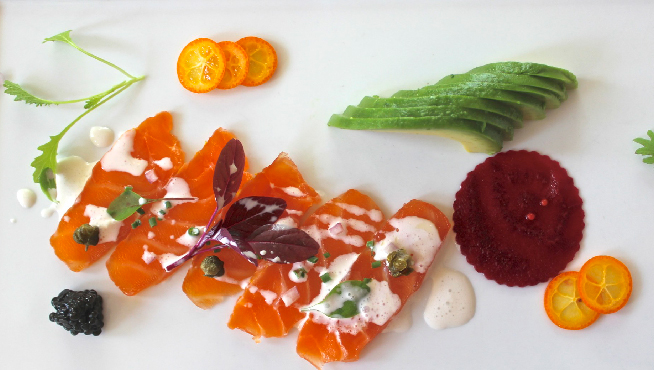

Dish of the Week
Sunday morning breakfast never varied in our house all the years I was growing up: lox and bagels lathered with Philadelphia cream cheese and thick rings of red onion. When, on my first trip to France, I ordered a first course of ‘gravlax’ thinking I’d come upon an old friend, what arrived at the table was exotic and unfamiliar ~ transparent slices of salmon cut so thinly they shimmered like silk, a languorous trail of crème frâiche, a light dusting of capers. On a separate plate were little pillows of pancakes called blini. My first thought, ‘ok, we’re not in Kansas anymore,’ was followed by complete surprise when I took that first bite. For all its refinements, the dish brought me home.
I never forgot the lesson: whatever hide 'n seek we play with food, signature flavors have the power to haunt us. Sure, in chasing them down we more often than not find ourselves disappointed. But on those rare occasions when we aren’t, the experience is a remarkable convergence of known yet new, comforting yet exciting.

Our first course on last Sunday’s Mother’s Day tasting menu was remarkable in precisely this way as it managed to remind me of my mother’s kitchen while seamlessly bridging the gap between homey and elevated. The taste of the sea was alive in the house cured salmon, a bright dollop of caviar like an exploding punctuation mark on the palate. The salmon was cured in equal parts salt and sugar with fresh dill, lemon and orange slices. The heirloom beets pickled in sugar, mustard seed and champagne vinegar, were punched out with a scalloped ring mold.
Everything on the plate played off or with the fish: the earthiness of the beets, the sharp bitterness of the kumquat, the creaminess of the avocado and the crème frâiche. Pink peppercorns, fresh chives, deep fried capers, opal basil and tiny mince of red onions ~ spicy herbal notes ~ wove in and around the salmon refreshing each bite. My mother would have loved it.

SOM's notes:
Sekthaus Solter Spätburgunder Brut Rosé, NV, Rheingau, Germany
A sparkling rosé wine is a great pairing to the first course on our Mother’s Day menu because underneath the German lingo this German sparkler is in fact simply a pink Champagne from Pinot Noir. Light bodied and dry, it delivers crisp red cherry and strawberry notes that stand out against a background of sorrel herb minerality. Brighter than any stateside Blanc du Noirs I've had, it's a perfect refreshing palate cleanser that elevates the richness of cured salmon and the crème fraîche, while holding it's own with the earthy and herbal elements of the dish, as well as the bright acids and tangy tartness of the kumquats.
Brendan O'Donovan
In the Gardens last week

The versatility of the Barndiva Gardens had a nice workout last week when days before double barrel weddings we played host to an Audi Sportscar Experience that brought close to two million dollars worth of exquisite vehicles into the Studio Gardens. It probably was not fair that we told our staff the cars were this year's bonus for their hard work.
Our beautiful Saturday wedding made the New York Times Wedding Section because the bride was the great great grand-daughter of our 27th President. That would be William Howard Taft, if you are counting. Aside from the impressive lineage (the bride's father is the former legal adviser to Secretary of State Colin L. Powell) this was one lovely couple who blessed their vows in the gardens on what turned out to be an unusually warm late spring evening.

All text and photos Jil Hales and Dawid Jaworski





















